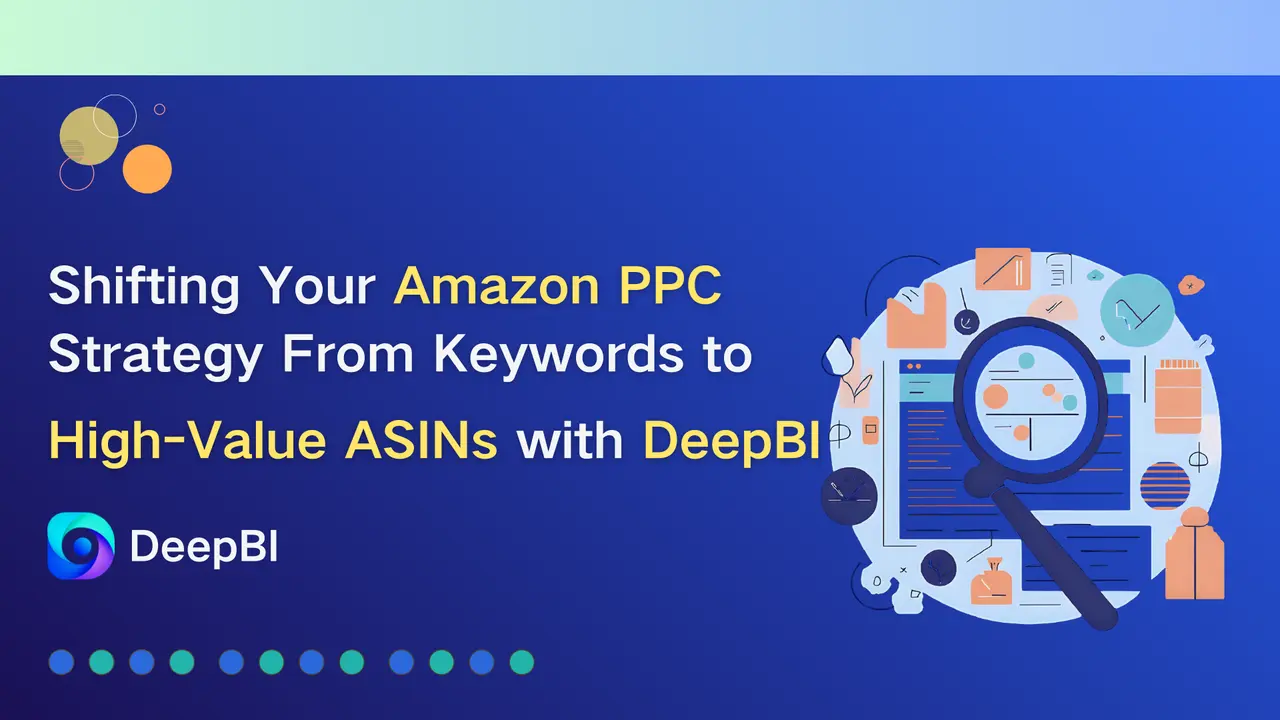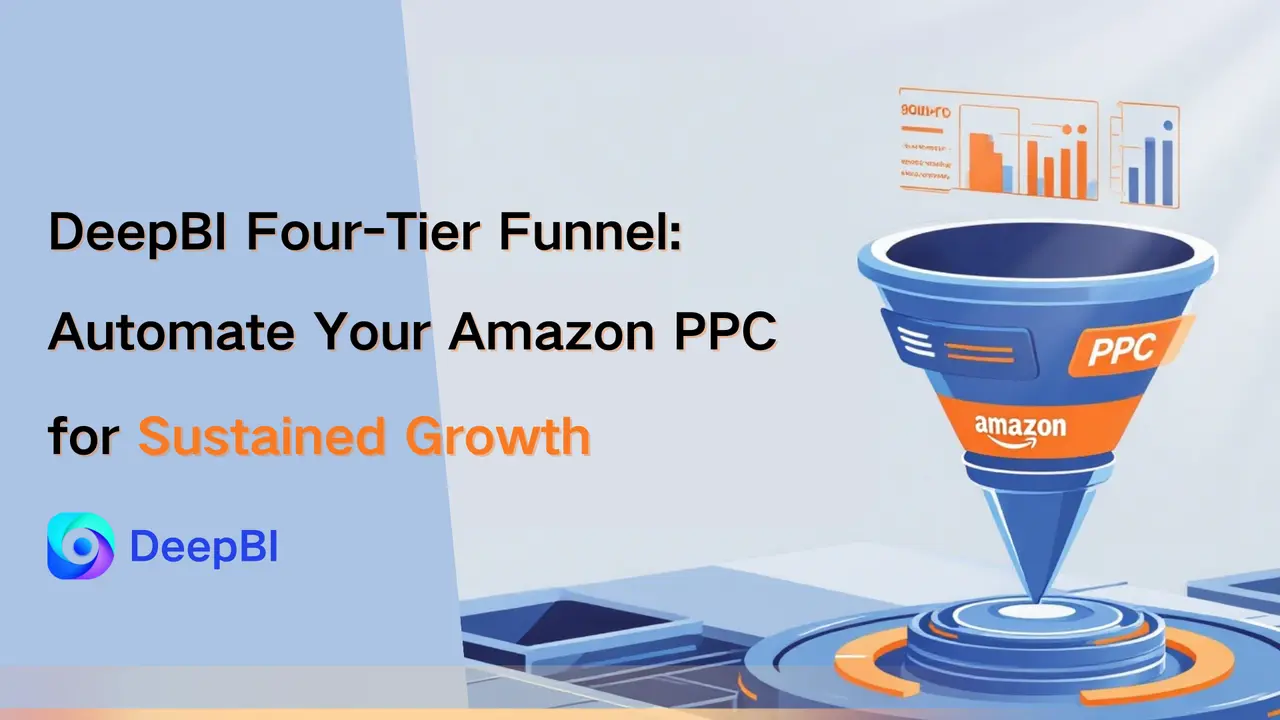Overview
The Amazon advertising ecosystem in the United States has entered a post-manual era. While most sellers still rely on dashboards and periodic bid adjustments, the marketplace itself operates at machine speed — where click prices, keyword rankings, and competitive bids fluctuate multiple times per hour.
This article examines the structural limitations of manual PPC optimization and presents DeepBI's adaptive AI system as a solution engineered for real-time synchronization between advertiser decisions and market behavior. Unlike rule-based automation tools that merely execute predefined conditions, DeepBI functions as a self-learning performance framework. It continuously analyzes behavioral data, detects performance gradients, and makes precise daily bid and budget adjustments through Amazon's Service Provider Network (SPN). DeepBI's advantage lies in the precision and effectiveness of its decisions, transforming vast amounts of marketplace data into consistent, high-quality decision outcomes.
The article outlines DeepBI's architecture in four layers — Exploration, Filtering, Precision, and Scaling — each corresponding to a distinct stage of the buyer journey. By modeling conversion probability and cost equilibrium dynamically, DeepBI maintains campaign profitability while eliminating manual decision lag.
A case study of a U.S.-based camera accessories brand demonstrates measurable performance impact: reduced ACoS, increased conversion efficiency, and decreased operational overhead.
Ultimately, this article argues that success in the modern U.S. Amazon marketplace no longer depends on who spends more, but on who optimizes more precisely.
DeepBI provides optimization — a closed-loop system that unites data interpretation, decision logic, and real-time execution, allowing U.S. sellers to maintain strategic control while achieving algorithmic speed.

The Pain Every U.S. Amazon Seller Knows

Each morning, U.S. brand owners log into Amazon Seller Central to the same paradox: Ad spend surges, but conversions remain static. The reason isn't inefficiency — it's response lag.
On Amazon, advertising outcomes don't change instantly after each bid adjustment. The system requires time to process changes — from recalculating ad eligibility to re-ranking keywords and stabilizing reporting. Typically, the effect of a new bid becomes visible within 30 minutes to several hours, and full stabilization may take up to 24 hours.
This natural lag in performance feedback means that both manual and automated systems operate under delayed data conditions. The real challenge is not reacting faster, but interpreting these lagging signals accurately and making adjustments with precision and confidence.
Understanding the Limits of Manual Optimization in a Dynamic Marketplace
Manual PPC optimization operates on human reaction cycles — typically measured in hours or days — while Amazon's marketplace operates on algorithmic cycles constantly evolving. The true challenge isn't about reacting faster, but about interpreting and acting on massive, constantly shifting data with accuracy and consistency. Because of this performance gap, it silently drains profit from thousands of U.S. sellers.
In 2025, this gap has widened due to three structural shifts in the U.S. Amazon market:
- Algorithmic volatility — Click prices and keyword competitiveness fluctuate multiple times per hour as automated bidding systems interact.
- Data density — A single ASIN can accumulate tens of thousands of data points daily across placements, times, and audiences.
- Operational inertia — Even the most disciplined PPC teams can only adjust bids and budgets periodically, not continuously.
As a result, even when human operators act quickly, their decisions are often based on incomplete or outdated information, because Amazon's system itself requires time to process bid changes and re-rank keywords.
Understanding Amazon's Bid Adjustment Lag
- Small bid adjustments (±10%): visible effects within 30–60 minutes
- Medium adjustments (±10–30%): visible effects in 1–3 hours
- Large adjustments or new keywords: 6–12 hours
- New campaigns or ad groups: up to 24 hours to stabilize
Best practice: wait at least 4–6 hours between bid changes to maintain learning stability and avoid over-adjustment.
This lag in performance feedback means that both manual and automated systems must operate with delayed data. The difference lies in how precisely and how broadly they can interpret that data. While skilled manual operators can use experience and intuition to make strong individual decisions, they still cannot process and react to millions of micro-signals across hundreds of ASINs daily.
In contrast, automated systems like DeepBI analyze these signals in aggregate — not to act faster, but to act more precisely and consistently. The result is a decision model that scales human judgment with data accuracy, ensuring each adjustment is backed by statistical evidence rather than isolated observations.
The Structural Failure of Manual-Only PPC Systems
Manual optimization assumes a stable advertising environment — one in which yesterday's performance predicts tomorrow's. But in the U.S. Amazon marketplace, the environment is non-stationary: every variable, from competitor bidding patterns to seasonal search intent, shifts in real time.
This means static decision cycles cannot sustain equilibrium.
A manual system performs three sequential steps: observe → decide → act.
An automated competitor performs these steps continuously and simultaneously.
The key difference isn't speed but scope and accuracy. DeepBI can process and evaluate far larger datasets than a human team can handle. This allows it to identify and act on optimization opportunities with a level of precision and consistency that manual management simply can't scale.
For high-competition U.S. categories — electronics, beauty, home improvement — this lag is the difference between margin retention and erosion.
The DeepBI Framework — "AI-Driven Market Synchronization"
DeepBI was engineered to eliminate manual response lag and reintroduce optimization between market motion and advertiser response.
Rather than relying on static rule sets, DeepBI operates through a continuous adaptive loop — a closed-system architecture that learns, predicts, and adjusts in real time.
Data Integration Layer
DeepBI connects through Amazon's Service Provider Network (SPN) API, ensuring direct, compliant data feed from advertising and performance endpoints.
Incoming signals include:
- Keyword-level click and conversion data
- ASIN and placement-level performance
- Competitor bid landscapes
- Temporal variables (time of day, day of week, seasonal patterns)
This data is refreshed multiple times per day, forming the foundation of live decision modeling.
Behavioral Modeling Layer
Instead of treating metrics like isolated variables, DeepBI builds behavioral correlations — understanding not just which keyword converts, but under what conditions.
For example:
- A keyword may convert strongly at a $0.95 CPC during weekdays but collapse under weekend competition.
- Certain ASINs outperform in mobile placements but not desktop carousel ads.
By continuously mapping these micro-conditions, DeepBI identifies conversion equilibrium points — where cost efficiency and performance intersect dynamically.
Decision Engine (Optimization Core)
This is where DeepBI differentiates itself from rule-based "automation" tools.
Traditional systems rely on conditional triggers (e.g., "If ACoS > 30%, reduce bid by 10%").
DeepBI replaces static rules with dynamic parameter adjustment, where actions are derived from real-time data distributions rather than fixed thresholds.
For instance, instead of lowering a bid based on an arbitrary ACoS ceiling, the engine analyzes the gradient of change in performance — determining whether the observed shift represents a temporary anomaly or a structural trend.
This statistical learning mechanism allows DeepBI to distinguish noise from signal, minimizing over-reaction and preserving campaign stability.
Execution Layer
The optimized parameters — bids, budgets, placements — are then applied instantly through the SPN interface.
Unlike advisory platforms that output recommendations for human approval, DeepBI executes adjustments directly, closing the feedback loop.
This continuous cycle — collect → model → decide → execute — repeats multiple times per day, maintaining alignment between campaign state and live market conditions.
The Four-Layer Optimization Funnel — A Systemic Model of Buyer Behavior
To reflect the actual journey of the U.S. Amazon shoppers, DeepBI organizes its decision logic into four optimization layers:
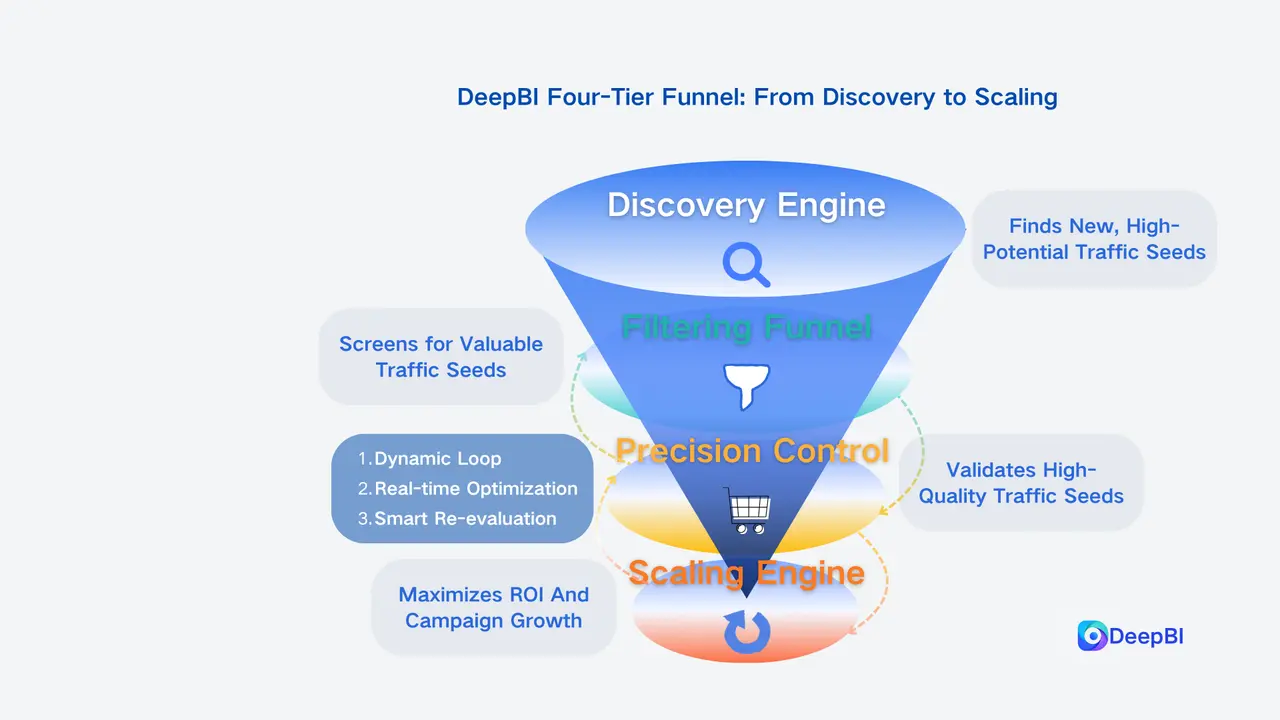
1. Exploration Layer (Market Discovery)
DeepBI continuously identifies untested keyword clusters and competitor ASINs with emerging potential. This process is guided by entropy-based selection, which prioritizes combinations where potential variance is high and data confidence is low — effectively allocating small, controlled budgets to discover new profitable pockets of traffic.
2. Filtering Layer (Traffic Qualification)
Not all traffic carries equal value. Using live conversion signals and probabilistic ACoS modeling, DeepBI suppresses low-intent impressions early. This step prevents wasted spend on audiences statistically unlikely to convert — a critical efficiency factor in high-CPC U.S. markets.
3. Precision Layer (Profit Core)
Once conversion stability is detected, DeepBI reallocates budget proportionally toward proven performers. Its reinforcement learning module prioritizes consistency of profitability over temporary spikes, ensuring sustainable ROI growth instead of volatile swings.
4. Scaling Layer (Expansion and Amplification)
DeepBI then models marginal cost versus incremental return, expanding spend only when additional investment is predicted to maintain profitability within defined tolerances. This safeguards margin integrity during aggressive growth phases — a frequent challenge for U.S. sellers during seasonal demand surges.
Case Study: North America — Camera Equipment Seller
We tested DeepBI on a real North American account in the camera equipment category and compared performance on DeepBI-managed campaigns vs. the seller's standard Amazon campaigns that were managed manually.
What We Measured
- Sales trend by campaign type (DeepBI campaigns vs non-DeepBI campaigns)
- Spend and ACoS trend for both campaign types
The charts show the monthly profile from February → August 2025, and here are the main takeaways:
Results Summary
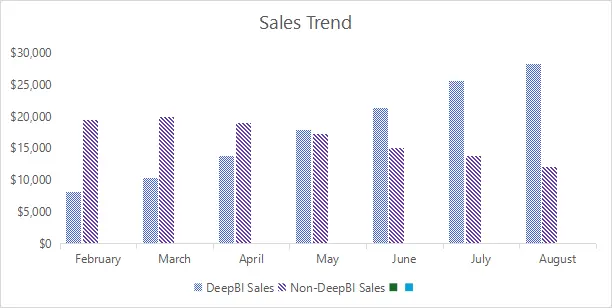
- DeepBI sales share steadily increased: Early in the test (Feb–Apr) DeepBI campaigns contributed modestly to total sales. Over subsequent months DeepBI's share rose substantially, and by mid-summer DeepBI campaigns were contributing a major portion of ad-driven sales — progressively replacing non-DeepBI ad plans.
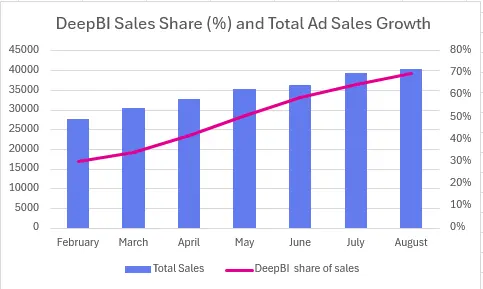
- Lower ACoS and better conversion efficiency: The ACoS curve for DeepBI campaigns consistently sat below the non-DeepBI campaigns in most months, meaning DeepBI produced sales more efficiently while maintaining or increasing sales volumes.
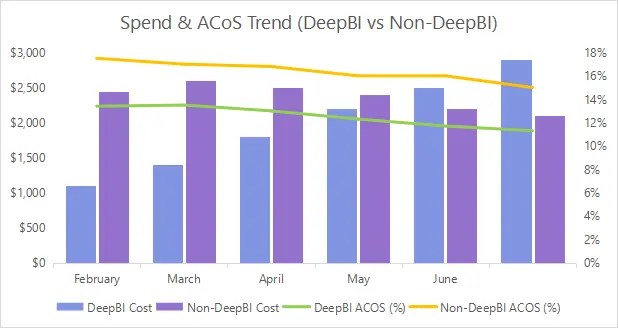
- Spend remained controlled while scaling results: DeepBI focused budget on high-quality traffic instead of broad, low-converting clicks — leading to better cost per conversion and more efficient use of ad dollars.
- TACoS note: Overall TACoS for the account rose across the period (because advertising increased as a share of total revenue while ad-driven revenue grew), so sellers should watch the balance between ad investment and organic sales growth. The net effect, however, was positive because the seller achieved higher scale and more efficient ad conversions.
Comparative Analysis — Why DeepBI Outperforms
DeepBI outperforms traditional automation and manual systems through its precision-driven approach. Unlike rule-based tools or purely manual methods, DeepBI's adaptive AI continuously learns from market conditions and adjusts strategies in real time, delivering superior performance consistency.
How to Get Started

- Set your objectives — define a target ACoS or growth goal. DeepBI accepts guiding constraints.
- Connect DeepBI to your Amazon account — as an SPN provider, we link directly to Amazon Ads.
- Choose the level of automation — you can customize rules (target ACoS, excluded keywords, etc.), but for best results follow the AI-led approach and let DeepBI manage day-to-day changes.
- Run alongside current campaigns — DeepBI will operate without disrupting your current structure and will progressively take over discovery, filtering, and scaling.
- Review insights — use DeepBI's listing and traffic reports to improve conversion rate and long-term organic lift.
Final Thoughts & Next Steps
The evolution of Amazon advertising has outpaced the capacity of human-managed systems. In the U.S. market — where algorithmic competition defines placement and profitability — precision is strategy.
DeepBI redefines PPC optimization by aligning data scale with strategic intent — not by acting faster, but by acting smarter. It is a closed-loop AI system that observes, learns, and acts itself.
For U.S. sellers facing data overload and time scarcity, DeepBI represents not just automation, but optimization and precision — the ability to keep every campaign aligned with every market movement, continuously.
👉 Visit www.deepbi.com to discover how precision-driven automation can transform your Amazon advertising.



